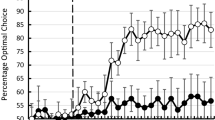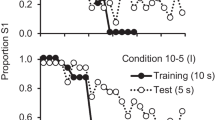Abstract
Three groups of rats learned a black-white discrimination in a Grice box. All subjects were reinforced with two food pellets for correct choices. No-Retrace subjects were confined in the negative end-box after errors; Retrace subjects were allowed to withdraw after errors from the negative end-box to the choice-point or start-box; and Take-Out subjects were manually removed from the negative end-box immediately after inspecting the empty food dish. All subjects were trained to criterion and then reversed to criterion. The Retrace group learned the original discrimination significantly slower than both the No-Retrace and Take-Out groups, which did not differ from each other. The same effect occurred on reversal. Apparently, the postnonrein forcement stimuli that the Retrace group encountered retarded discrimination learning.
Similar content being viewed by others
Reference Note
DENNY, M. R. 1977. Allowing withdrawal from nonreinforcement: Inhibition of runway performance in partially reinforced rats. Paper presented at the annual meeting of the Midwestern Psychological Association, Chicago, May.
References
ADELMAN, H. M., & MAATSCH, J. L. 1955. Resistance to extinction as a function of the type of response elicited by frustration. Journal of Experimental Psychology, 50, 61–65.
BARTUS, R. T., & JOHNSON, H. R. 1976. Effects of postresponse visual stimuli on visual discrimination learning in the rhesus monkey. Learning and Motivation, !, 431–445.
BARTUS, R. T., & LeVERE, T. E. 1976. Storage and utilization of information within a discrimination trial. In D. Medin, W. Roberts, & R. Davis (Eds.), Processes of animal memory. Hillsdale, N.J.: Erlbaum.
DALY, H. B., & McCROSKERY, J. H. 1973. Acquisition of a bar-press response to escape frustrative nonreward and reduced reward. Journal of Experimental Psychology, 98, 104–112.
DENNY, M. R. 1971. A theory of experimental extinction and its relation to a general theory. In H. Kendler & J. Spence (Eds.), Essays in neobehaviorism: A memorial volume to Kenneth W. Spence. New York: Appleton-Century-Crofts.
DENNY, M. R., & ADELMAN, H. M. 1955. Elicitation theory: I. An analysis of two typical learning situations. Psychological Review, 62, 290–296.
GELLERMAN, L.W. 1933. Chance orders of alternating stimuli in visual discrimination experiments. Journal of Genetic Psychology, 42, 207–208.
GRICE, G. R. 1948. The acquisition of a visual discrimination habit following response to a single stimulus. Journal of Experimental Psychology, 38, 633–642.
HULL, C. L., & SPENCE, K. W. 1938. “Correction” vs. “non-correction” methods of trial-and-error learning in rats. Journal of Comparative Psychology, 25, 127–145.
KALISH, D. 1946. The non-correction method and the delayed response problem of Blodgett and McCutchan. Journal of Comparative and Physiological Psychology, 39, 91–108.
KAMIN, L. J. 1969. Predictability, surprise, attention, and conditioning. In B. A. Campbell & R. M. Church (Eds.), Punishment and aversive behavior. New York: Appleton-Century-Crofts.
LeVERE, T. E., & BARTUS, R. T. 1973. Stimulus information and primate discrimination learning: The influence of postresponse stimulus information. Learning and Motivation, 4, 305–313.
MACKINTOSH, N. J. 1974. The psychology of animal learning. New York: Academic Press.
MUNN, N. L. 1950. Handbook of psychological research on the rat. Boston: Houghton Mifflin.
SCHEFFÉ, H. 1959. The analysis of variance. New York: John Wiley & Sons.
SEWARD, J. P. 1943. An experimental analysis of maze discrimination. Journal of Comparative Psychology, 35, 17–27.
TOWART, E. M., & BOE, E. E. 1965. Comparison of the correction and the rerun noncorrection methods in maze learning. Psychological Reports, 16, 407–415.
WAGNER, A. R., RUDY, J. W., & WHITLOW, J. W. 1973. Rehearsal in animal conditioning. Journal of Experimental Psychology, 97, 407–426.
Author information
Authors and Affiliations
Additional information
This research is based upon a thesis submitted by the first author in partial fulfillment of the M.A. degree at Western Michigan University, under the guidance of the second author.
Rights and permissions
About this article
Cite this article
Johnson, C.M., Denny, M.R. Effect of Withdrawal from the Negative Cue on Learning a Two-Choice Discrimination. Psychol Rec 29, 85–91 (1979). https://doi.org/10.1007/BF03394593
Published:
Issue Date:
DOI: https://doi.org/10.1007/BF03394593




